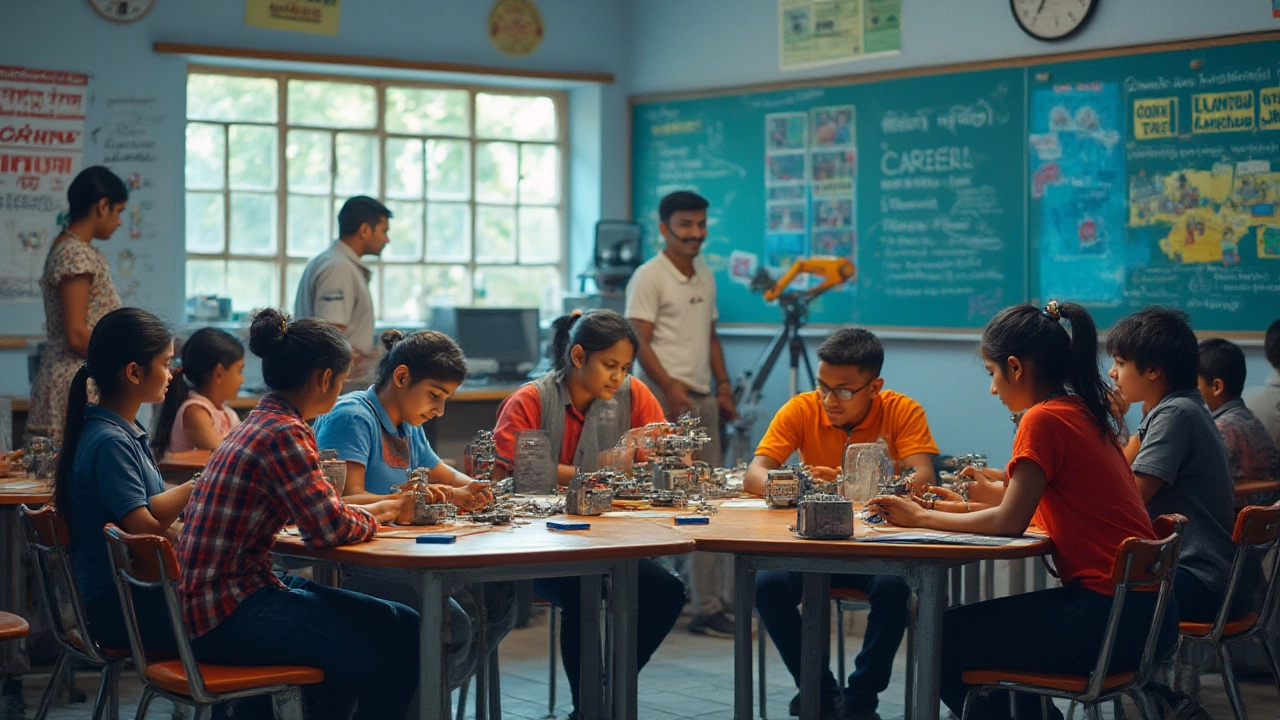If you ask anyone in Chennai where the real jobs are going in 2025, the answer might surprise you. It’s not the fancy engineering colleges or another round of computer science grads. Instead, look at the neighbours who’ve finished short stints in vocational courses and are already earning decent money—some even before their peers get their graduation photos framed. Vocational education doesn’t get the applause it deserves, but these programs are where raw skills turn into fast-track careers. Let’s unlock what makes vocational courses tick, which ones are truly the best, and how to pick the right path for a future that isn’t buried in boring theory or endless exams.
Why Vocational Courses Are Becoming the First Choice
Right now, most people think of vocational courses as the “plan B” or what you do if you’re not cut out for universities. That’s seriously outdated thinking. In India, the government’s Skill India Mission tells the story. By 2025, over 400 million jobs require specialized skills, not degrees. Fast-paced industries just can’t wait for four-year grads—they need skilled hands-on workers, yesterday. Walk through central Chennai’s industrial hubs or even the IT corridors, and you’ll find companies offering direct placement to those with the right vocational certificates—no big interviews, just a demo of what you can do.
Here's a wild stat from the National Skill Development Corporation: Placement rates after top vocational courses stand at 78% within six months, especially in technical trades and health care. Compare that to traditional degree job rates, which hover —often way below 65% without campus placements—even for engineering or commerce. You want a future proof job? Learn a skill, not just theory.
Vocational courses are also shorter. Most last anywhere from three months to two years. You’re out in the world, earning, while many others are still slogging through textbooks. Plus, with work-from-home and gig jobs growing post-pandemic, more people are picking up trades like digital marketing, graphic design, and even home health care because they’re practical and pay off quickly.
Parents are starting to see the change as well. A 2024 survey in Tamil Nadu showed that about 62% of parents would consider putting their kids in a good vocational course, especially after seeing neighbours land IT jobs or set up salons after six months of training. Even companies are stepping in, with several ITIs (Industrial Training Institutes) now tied-up with companies for guaranteed placements—something most universities can only dream of.
The Best Vocational Courses To Consider in 2025
This is where it really gets interesting. Not all vocational courses are created equal. Some open quick doors; others lead to high-paying, specialized jobs. Let’s break down the top ones that really work in today’s job market—no fluff, just practical picks:
- Information Technology (IT) and Digital Skills: Courses in web development, mobile app creation, cloud computing, and cybersecurity are on rocket fuel right now. The IT-ITES sector alone is expected to need over 1 million new skilled workers in India by the end of 2025. Entry salaries are as high as Rs 3.5 lakhs per annum for those with smart portfolios—even if you’ve just completed a 6-12 month vocational course.
- Healthcare and Allied Services: Want stability and a job that’s always in demand? Think medical lab technician, pharmacy assistant, or even dental hygienist. The Indian healthcare boom isn’t slowing. In fact, paramedical roles, especially after short but intensive courses, often come with jobs waiting the day you get your certificate.
- Electrician/Plumbing/Automobile Technician: These “traditional” trades are seeing a digital makeover. Electricians now need to know about smart homes; automobile techs need to handle electric vehicles. Companies like Maruti Suzuki and Tata regularly scoop up fresh talent from ITIs, offering salaries that can touch Rs 25,000 per month at the entry-level, with quick promotions tied directly to hands-on skill.
- Fashion and Beautician Courses: Chennai’s malls and film industry guarantee that skills in beauty therapy and styling are always in demand. A short vocational course in hair and makeup can land you jobs in high-traffic salons or even push you toward freelance gigs for movies and weddings, sometimes earning more per month than junior engineers. The best part? Flexibility—you can start your own brand, work part-time, or scale as you wish.
- Digital Marketing and Multimedia: Every brand, big or small, now needs a digital face. Courses in social media marketing, paid ads, and graphic design can last three to twelve months. Entry-level jobs pay around Rs 18-24K per month, but if you can show real projects or client work, the sky’s the limit. Who knew a year of practical learning could land you a spot at a top agency?
- Culinary Arts and Bakery: Skilled chefs and bakers are not just limited to five-star hotels anymore. Entrepreneurial chefs are opening boutique bakeries or food trucks after short vocational courses, sometimes making more than engineers with less stress and a lot more creative freedom. If you love cooking, training under a master chef can pay back ten times over.
Let’s take a quick glance at earning potential in best vocational courses versus traditional degrees:
| Course Type | Duration | Starting Salary (Rs/month) | Placement Rate (%) |
|---|---|---|---|
| IT & Digital Skills | 6-12 months | 22,000 - 35,000 | 76% |
| Health & Paramedical | 1-2 years | 18,000 - 28,000 | 81% |
| Electrician/Technician | 12-18 months | 15,000 - 25,000 | 73% |
| Beautician/Fashion | 6-12 months | 20,000 - 30,000 | 67% |
| Culinary Arts | 8-16 months | 20,000 - 32,000 | 70% |
| Bachelor’s Degree (General) | 3-4 years | 16,000 - 22,000 | 54% |
The data speaks for itself—these short-term, skill-based courses are not only faster and more affordable but often lead to better or at least equal pay as a regular degree.

How to Pick the Right Vocational Course for You
The first rule: don’t just follow the crowd. Picking the right vocational course is more about knowing what you actually want to do every day and what skills fit your personality. Here’s how to crack the code:
- Figure Out Where Your Interest Lies: If you’re bored stiff at the thought of fixing wires, don’t pick electrician training—even if it pays well. Love talking to people and have an eye for colour? Beauty therapy or digital marketing might be your thing.
- Research Job Demand in Your Area: What works in Chennai may look different in Kochi or Delhi. Scan job boards, talk to local businesses, or check placement rates at nearby institutes—the right course is the one with jobs waiting.
- Check for Industry Tie-ups: Courses with guaranteed placement, real apprenticeships, or “earn while you learn” models are gold. A lot of ITIs and skill centers now have direct links with companies. Don’t settle for a course that just hands you a certificate—ask where their students work now.
- Verify Accreditation: Nobody wants a fake diploma. Make sure the institute is recognized by the National Skill Development Corporation (NSDC), state technical boards, or known companies. Employers ask for these, so you should too.
- Talk to Past Students: The best ‘prospectus’ is a real human who’s finished the course. Ask them what a day looks like, how the teachers are, and how quickly they got jobs after finishing. Most good centers are happy to connect you.
- Look for Hands-On Training: The biggest difference between a vocational course and a regular degree is the “learn by doing” approach. If your course is just lectures, run. You want workshops, labs, actual projects—because that’s what companies look for.
Keep an eye on costs, too. Most of these courses cost far less than a college degree and often have loan or scholarship options, especially for girls or first-generation learners. Many government ITIs are almost free after applying for state aid. If you don’t want to be stuck with hefty debt for years, this is the smarter path.
Also, don’t ignore the internet. Today, online platforms like NSDC eSkill, Coursera, UpGrad, and even YouTube offer certified skill programs that you can take from home, sometimes even live-streamed from industry experts. Hybrid learning (half online, half hands-on) is picking up, so make sure your course is up to date with tech trends.
Tips to Get the Most Out of Your Vocational Training
Getting into a good vocational course is just the start. Here are some inside tricks to get the best results, faster jobs, and a better shot at promotions later on:
- Build a Real Portfolio: If you’re into digital skills, collect your best work into an online portfolio—even a simple Google Drive folder will work. For trades, keep photos or videos of projects (think before/after shots for plumbing, wiring diagrams, or cake photos if you’re a baker).
- Find a Mentor: This could be your course instructor or someone working in the field. Mentors share job leads, keep you on track when things get rough, and help you dodge rookie mistakes.
- Start Freelancing Early: Don’t wait for your certificate. Platforms like UrbanClap or Upwork help you get real-world gigs—even while you train. It builds your confidence and looks great on your resume.
- Practice, Practice, Practice: Skill-based courses reward those who do, not just watch. Volunteer for extra projects, apprentice on weekends, or help family/friends with your new knowledge. The more you do, the faster you learn—and the better you get paid.
- Network with Classmates: The people next to you in class are tomorrow’s coworkers, business partners, or job leads. Make friends, stay in touch—that’s how the Chennai job grapevine works best.
- Stay Updated with the Latest Tech: Especially in IT and technical trades, new tools and trends pop up constantly. Even if your course doesn’t teach it, use YouTube, LinkedIn Learning, or free webinars to keep up-to-date and stand out when you apply for jobs.
- Attend Job Fairs and Placement Drills: Many training centers host on-campus job fairs. Dress smart, bring copies of your certificate and portfolio, practice a quick self-intro (“Tell me about yourself”), and collect every contact card you get.
- Don’t Fear Side Hustles: India’s freelance economy is booming. Use your skills for side projects—be it house wiring, digital ads for small shops, or baking cakes for neighbourhood parties. Sometimes, these side gigs kick off full-time entrepreneurship without you realizing it.
Vocational training isn’t about settling for less. It’s about cutting straight to the skills that matter, skipping the theoretical clutter, and gearing up for jobs that need you, not just your degree. The best vocational course? That’s the one matched to your interests, done from a credible center, and packed with enough hands-on practice that employers line up before your certificate even dries. Watch the world catch up—it’s the skilled hands, not the bookworms, who are now running the show.
